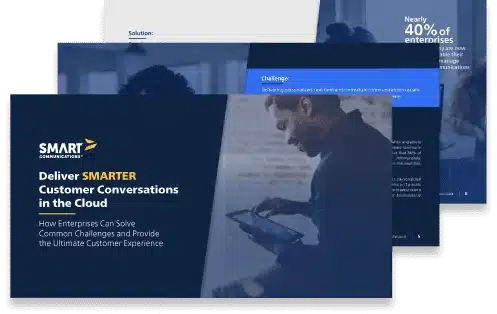Embedded Lending: How Customer Expectations Are Changing the Rules of Traditional Financing
By: Karen Oakland, VP of Financial Services Marketing at Smart Communications
The banking industry can seem like one gigantic, complex experiment these days, with embedded finance, open banking and fintechs top of mind for many executives. According to new research Smart Communications conducted recently with MoneyLIVE, in partnership with OneSpan, 45% of loans could be obtained through non-financial ecosystems over the next five years—a clear sign that borrowers are leaving banks in exchange for the speed and convenience of accessing credit from other sources, from Amazon and Apple to other fintech app-based businesses.
So, what are the strategies banks and lenders are developing to compete and remain relevant in this time of disruption? One key is in making sure the customer experience is frictionless and consistent across digital and mobile channels – for both borrowers and third-party business partners.
Below, we outline key findings from the MoneyLIVE research. For starters, let’s dig into what embedded lending means.
RELATED READING | ‘The Future of Customer Experience in Embedded Lending’
What is Embedded Lending and Why Does It Matter?
Embedded lending (also referred to as embedded finance) can mean a variety of things, from Buy Now Pay Later (BNPL) services to Banking as a Service (BaaS) offerings delivered in partnership with non-banks or smaller institutions. Basically, it’s about shifting the availability of financing closer to the point of sale, or “embedding” it into the buying process.
Many incumbent banks have launched their own BNPL offerings to compete with fintechs like Klarna or Affirm. Others are building partnerships to offer IT and operational processes to non-banks. Business lending is seeing particular growth. A 2022 study from Bain Capital predicts that embedded finance-driven business lending will grow five-fold over the next five years in the U.S. alone, from $200 million in 2021 to $1.3 billion by 2026, thanks to the rise of a range of new specialist providers.
Embedded lending speaks to the necessity for credit solutions that deliver the instant gratification expected by today’s digitally savvy customers, and shines a light on consumers’ desire for convenience, ease and speed. Data shows this is particularly important for younger generations who may be shopping for credit for the first time – and tend to be “mobile first.”
As noted by Bain: “In the years to come it will have a transformative effect on the relationship we have with our finances, removing friction from the sector and making financial services more contextual, accessible and helpful.”
Embedded Lending: Driving Innovation in Customer Experience
So as this embedded lending concept takes off, it’s clear that banks and lenders need to focus on providing a seamless digital-first customer experience – not only for their own traditional loan products, but for partner solutions as well.
That means shifting from paper forms to digital and doing the necessary optimization to reduce abandonment rates. It means shifting to on-demand communications produced in real time on demand and available for e-signature, perhaps white labeled for a partner brand, rather than sent out in a huge batch. These are all focus areas for innovation, our research shows.
- 93% of survey respondents said the rise of embedded lending will make smooth and effortless loan applications not just a competitive differentiator, but a survival factor
- 60% of respondents expect it will be “very important” to provide borrowers with the option to switch channels and stop/start on different devices (though one in five don’t offer this today)
- 89% say paper or static web forms are trigger points for form abandonment, yet 65% still use them
- At least 75% expect to be able to communicate with borrowers via messaging apps, social media and voice-activated digital assistants by 2027
Reducing abandonment levels have been found to be highest when loan applicants are forced to enter in repetitive information while switching channels; a headache that’s typical when using paper forms, fillable PDFs and/or one-size-fits-all web forms. This manual approach increases the burden on the customer and drives them to other lenders that seem easier to use. This is the sort of problem we solve with our SmartIQ forms automation solution.
Is Friction Good or Bad? Regulators Weigh In
Eliminating friction from the customer journey seems like a smart idea to compete in this disruptive era of embedded lending. However, some federal regulators are taking a different tack, requiring banks to include more friction. In July 2022, the UK Financial Conduct Authority, for example, announced a new Consumer Duty requiring every financial firm to ensure that “it includes appropriate friction in its customer journeys to mitigate the risk of harm and give retail customers sufficient opportunity to understand and assess their options.” The Dutch Payments Association has also suggested that such “positive friction” should be introduced BNPL payment journey. Similarly, the Consumer Financial Protection Bureau (CFPB) in the U.S. and Australian Prudential Regulation Authority (APRA) are increasing regulation of lender communications.
So what gives? It reflects a focus on making sure that borrowers understand the cost of borrowing money, especially when it’s faster and easier to get through embedded lending products. Nearly all respondents – 97% – agree that responsible lending will require more digestible and personalized customer communications about the affordability and cost of credit to ensure that borrowers are making informed decisions. This is a great reason why incumbent banks and lenders need to strengthen and modernize their customer communications management solutions, taking advantage of automated workflows and open APIs to make sure their documents and messages are as personalized as possible while being fully compliant and in the right brand.
Conclusion
Overall, leaders across the finance industry are beginning to make strides toward innovative processes and solutions that will significantly reduce customer effort, improve engagement and ultimately close more loans. The MoneyLIVE study shows that as the financial world responds to shifting customer expectations, embedded lending presents both an opportunity for growth and a possible threat to lenders that don’t adapt and embrace new strategies.
Ultimately, it could make the difference between financial institutions becoming future-ready or stone-age relics.



